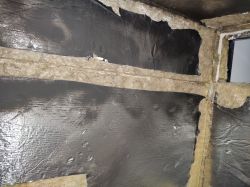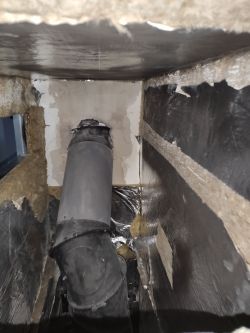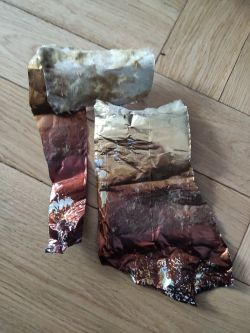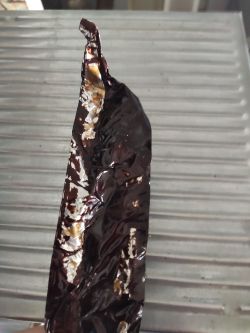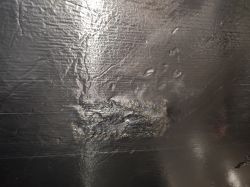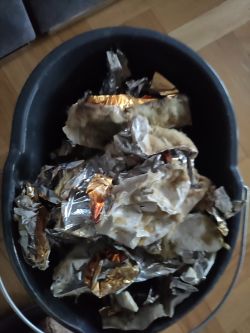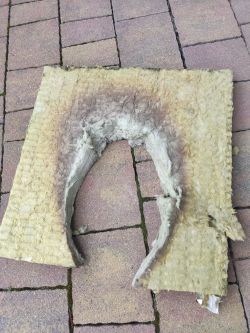Hi,
I have such a problem - when using the fireplace in my house you can smell burning puffs - something more like burned plastic than wood smoke, although it is difficult for me to describe it and clearly state that it is not smoke from the hearth.
I bought the house second-hand with a ready-made fireplace, so I don't know the technical details.
At the top of the chimney, I put an insulated meter extension and a fireman to correct the cug and prevent smoke from entering the vents.
The smell is most likely coming from the hot air vents and sometimes it can be felt intensely on the first floor of the house - it is also clearly warm there from the fireplace, and much less downstairs.
I opened the grilles today to check if there is any leakage in the flue gas pipe and it is difficult for me to clearly say if there is a leak. There are no 'stains' anywhere, there are black raids which are rather paint applied at the assembly stage.
I took a series of photos and I have a request for help with the analysis and a few questions at the bottom.
The appearance of the chimney connection to the fireplace insert - these black raids are something like spray paint - it is not rather a smoke raid, it does not come off when touched with a finger, but can be scraped off with a screwdriver:

Chimney connection to the insert:
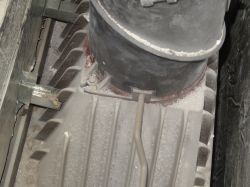
Fragment of a sooty looking pipe with an inspection window:
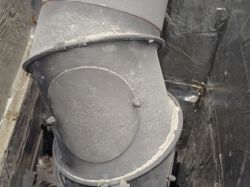
Once again, the raid on the wall - as I mentioned above - it looks like spray paint, it does not come off when touched, it does not get dirty:
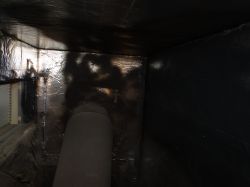
A fragment of the exposed thermal insulation - you can see that it is 'burnt':

Sealing or raids on the pipe:

The last photo, least clearly, from a borescope camera, showing the seal / tarnish on the chimney, at the connection to the cartridge. This white coating is like dust - it comes off when touched:
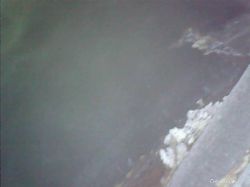
I have read a lot of similar topics, but would like to advise someone with experience.
And the questions are:
1. Can you find a leak based on the photos?
2. If it is a leak, is it possible that it is an effect of structural burn-out and will pass over time? The fireplace was hardly used, we smoke sporadically, but so far I have not noticed a downward trend ...
3. If it is firing the structure, is it possible to do something without dismantling the building and try to remedy the problem?
4. If it is impossible to do without undressing, then in general - what can be done?
5. Or maybe do nothing and it will just burn out?
6. How can I be sure that the chimney is tight? I came up with the idea to put a "disco" smoke machine in the fireplace (the hearth is tightly closed) and watch if smoke is escaping somewhere - does it make sense? The test would, of course, be performed 'cold'.
I have such a problem - when using the fireplace in my house you can smell burning puffs - something more like burned plastic than wood smoke, although it is difficult for me to describe it and clearly state that it is not smoke from the hearth.
I bought the house second-hand with a ready-made fireplace, so I don't know the technical details.
At the top of the chimney, I put an insulated meter extension and a fireman to correct the cug and prevent smoke from entering the vents.
The smell is most likely coming from the hot air vents and sometimes it can be felt intensely on the first floor of the house - it is also clearly warm there from the fireplace, and much less downstairs.
I opened the grilles today to check if there is any leakage in the flue gas pipe and it is difficult for me to clearly say if there is a leak. There are no 'stains' anywhere, there are black raids which are rather paint applied at the assembly stage.
I took a series of photos and I have a request for help with the analysis and a few questions at the bottom.
The appearance of the chimney connection to the fireplace insert - these black raids are something like spray paint - it is not rather a smoke raid, it does not come off when touched with a finger, but can be scraped off with a screwdriver:

Chimney connection to the insert:

Fragment of a sooty looking pipe with an inspection window:

Once again, the raid on the wall - as I mentioned above - it looks like spray paint, it does not come off when touched, it does not get dirty:

A fragment of the exposed thermal insulation - you can see that it is 'burnt':

Sealing or raids on the pipe:

The last photo, least clearly, from a borescope camera, showing the seal / tarnish on the chimney, at the connection to the cartridge. This white coating is like dust - it comes off when touched:

I have read a lot of similar topics, but would like to advise someone with experience.
And the questions are:
1. Can you find a leak based on the photos?
2. If it is a leak, is it possible that it is an effect of structural burn-out and will pass over time? The fireplace was hardly used, we smoke sporadically, but so far I have not noticed a downward trend ...
3. If it is firing the structure, is it possible to do something without dismantling the building and try to remedy the problem?
4. If it is impossible to do without undressing, then in general - what can be done?
5. Or maybe do nothing and it will just burn out?
6. How can I be sure that the chimney is tight? I came up with the idea to put a "disco" smoke machine in the fireplace (the hearth is tightly closed) and watch if smoke is escaping somewhere - does it make sense? The test would, of course, be performed 'cold'.



